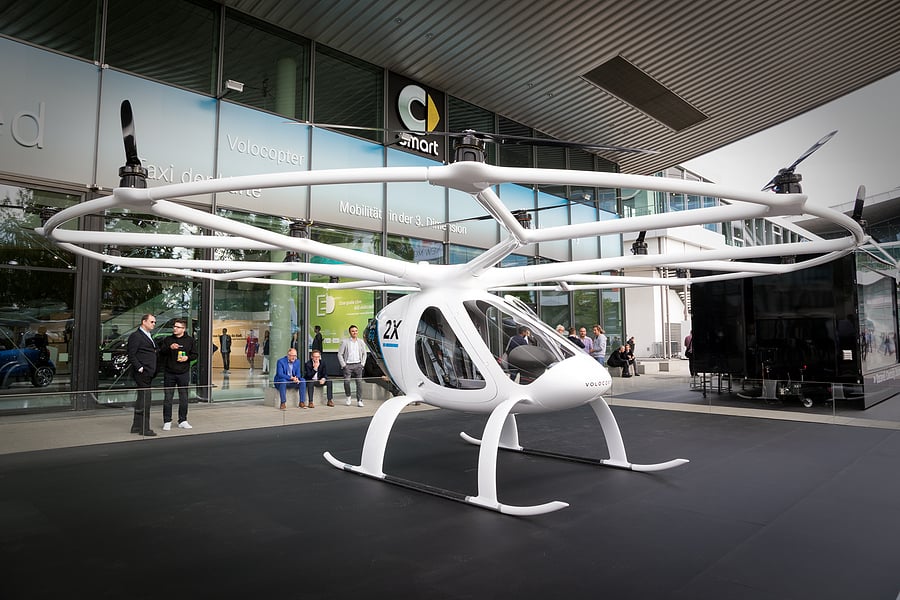The Current State of eVTOL Progress
The full deployment and consumer adoption of eVTOL aircraft may have the potential to be realised over the coming years. Several companies are already investing in eVTOL aircraft research and development to achieve urban air mobility (UAM) air taxis for commercial public transportation.
The very industry, in fact, has the potential to be worth 1.5 trillion USD by 2040. America's Uber and Germany's Volocopter have high stakes in this industry through Uber Elevate and the VoloCity air taxi, which could one day offer customers affordable air taxi fares. Also, Japan's SkyDrive, in collaboration with Toyota, has successfully tested its manned eVTOL, the SD-03 aircraft.
On top of the above, the electric propulsion technology utilised by eVTOL aircraft reduces noise emissions, power consumption, and extends range. Players in this industry, such as Lillium, Wisk, Joby Aviation, and Bell (among many others) are leveraging the technology to achieve UAM air taxis in the shortest time possible.
The following are a few of the latest eVTOL development programmes that are nearing completion:

The Volocopter: a fully electric, manned vertical takeoff and landing aircraft at Frankfurt IAA Motor Show 2017
Image credit: Bigstock
The Viability of Air Taxis for Commercial Transport
Aside from the need to achieve an eVTOL-friendly infrastructure, the viability of commercial UAM air taxis also depends on the technology’s affordability, power capabilities, ease of parking, and of course regulations and safety precautions.
With these points in mind, the following subsections cover some of the key points that engineers and manufacturers will need to consider.
The Question of Affordability
Will eVTOL aircraft be only accessible to the rich? Manufacturers and investors are considering this pertinent issue before the transport’s deployment. Although its exact ticket price for flights is yet to be announced, Volocopter’s VP of public affairs has told consumers that the VoloCity craft would not be affordable to only the rich. He explained that with an initial price of $300, its price would become competitive with Uber Black. And fortunately, because the industry may offer a perfectly competitive economy, it may not be far-fetched to expect other companies’ ticket cost to be in the same price range.
Power Demands
Batteries power most eVTOL aircraft. But the question remains whether batteries are enough to effectively and efficiently power them for the rigours of commercial transport. Today’s hybrid hydrogen fuel cells and lithium-ion batteries do already show the potential to improve eVTOL powering, and hydrogen fuel cell stacks have also been used in CityHawk’s electric motors.
In fact, particularly when compared to other means of urban mobility, such as petrol-powered cars and motorbikes, eVTOL aircraft promise clean energy. This suggests that their energy storage methods will be an incentive for engineers and manufacturers to add battery-powered UAM technologies to the transport sector.
On top of this, automakers’ interests in electric and self-driving vehicles are currently boosting R&D into more energy-dense batteries. But, especially in the context of eVTOL design and manufacturing, researchers must consider the weight of such batteries for their application in eVTOL aircraft. Fortunately, though, several studies have shown the viability of lighter and energy-denser batteries in coming years. For example, a study published in Energy Technology reports that lithium-sulfur (Li-S) batteries have the potential to power certain eVTOL aircraft at peak power requirements of 4 to 5 °C (more information on Li-S energy storage in eVTOLs can be read here on eVTOL.com).
The Parking and Storage Demands of eVTOL Aircraft
The question of providing parking and storage facilities for eVTOL aircraft is of course a challenging one. Due to the population density of urban cities, parking spaces or helipads are already scarce and expensive, even with only traditional transport in mind. However, authorities on vertical flight transport, such as Uber Elevate in its white paper, propose a VTOL-friendly infrastructure that uses ‘vertiports’ (vertical takeoff airports, which are already on the horizon at the time of writing) as a promising solution to accommodate the upcoming increase in aircraft traffic.
Regulatory Compliance
Regulatory bodies like the European Union Aviation Safety Agency (EASA) and Federal Aviation Administration (FAA) are currently focused on having eVTOL manufacturers take every precaution to ensure standardised, safe aircraft deployment. Consider, for instance, the aforementioned S-4 by Joby Aviation, which has recently obtained its FAA certification and military airworthiness approval. Both are milestones for the deployment of commercial UAM transport.
Moreover, Volocopter, being the only eVTOL company that has received design organisation approval from EASA, is about to receive certification for its VoloCity air taxi. The Lilium Jet is also not left out as it is currently undergoing certification testing with the EASA and the FAA. These clear-cut regulatory approvals from such transport aerospace authorities reflect eVTOL crafts’ viability for regulated and safe commercial flights.

While commercialised, manned VTOL vehicles are yet to be realised, their unmanned equivalents (such as camera-mounted drones) have been commonplace for years. Pictured: the Schiebel Camcopter S-100 VTOL aircraft
Image credit: Wikimedia Commons
How Soon Will eVTOL Aircraft Be Deployed for Commercial Transport?
Major manufacturers and investors project that, as early as 2024, eVTOL taxis may make their commercial entry into service. With these projections, it may be realistic to estimate that air taxis’ deployment may be by or before 2030, provided everything goes according to plan.
The age of vertical takeoff and landing aircraft may indeed be drawing near. Major manufacturers and investors are already working tirelessly for the achievement of commercialised urban air mobility by ensuring the necessary regulatory compliance, safety by continuous testing, adequate powering and recharging, and affordability of their air taxis.
Ultimately, it is hopeful, and perhaps even feasible, that UAM taxis will no longer be seen on television screens only—but also live in our cities before the end of the 2020s.





